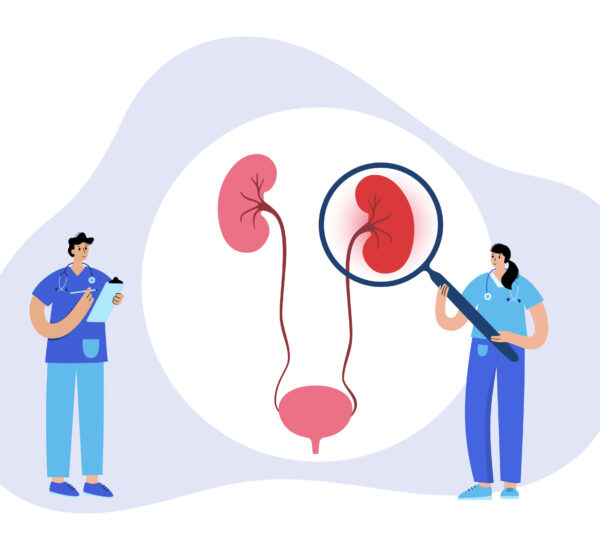There is a common condition that can affect the kidneys and beyond. It involves the severe infection, specifically in the upper urinary tract area. This type of infection typically involve severe pain in various areas such as both side and lower back. Despite producing a standard uti symptom, it is still vital to know the key difference when the upper tract infection occurs.
In this blog, we’ll delve into the various aspects that may trigger the infection in this area of the urinary tract. Furthermore, patients can be well aware of their current condition with the help of this comprehensive guide. Let’s begin!
Understanding Upper Urinary Tract Infection

An upper urinary tract infection refers to an infection that occurs in the kidneys or the ureters, the tubes that connect the kidneys to the bladder. These infections are typically caused by bacteria, such as Escherichia coli, entering the urinary tract, leading to inflammation and an immune response.
When bacteria enter the upper urinary tract, they can cause a range of symptoms. These symptoms can vary in severity depending on the individual and the extent of the infection. If left untreated, upper urinary tract infection can have serious consequences on kidney function and overall health.
It is important to seek medical attention from a health expert if you suspect you have an upper urinary tract infection. This person can perform tests, such as a urine culture, to confirm the presence of bacteria and determine the most appropriate treatment plan.
Common Causes of Upper Urinary Tract Infection
Various factors can contribute to the development of upper urinary tract infection. Each can heavily impact the patient’s health as it can possibly be the reason for its progression. With uncontrolled factors, it can be detrimental to the patient with upper urinary tract infection. Fortunately, patients can be well guided through understanding the common causes of this infection. Let’s discuss them below!
The most common cause is the migration of bacteria from the lower urinary tract, such as the bladder, into the upper urinary tract. This can occur when bacteria travel up the ureters, which can happen due to factors such as urinary stasis (when urine does not flow properly) or the presence of a urinary obstruction.
Other risk factors for upper UTIs include urinary tract abnormalities, such as structural defects that make it easier for bacteria to enter and infect the upper urinary tract. Kidney stones, which can obstruct the urine flow, can also increase the risk of infection. Individuals with a suppressed immune system, whether due to certain medical conditions or medications, are also more susceptible to upper urinary tract infections.
Aside from that, catheter use is another common risk factor for upper UTIs. Catheters are medical devices that are inserted into the bladder to drain urine in individuals who are unable to urinate on their own. While catheters can be life-saving in certain situations, they can also introduce bacteria into the urinary tract, increasing the risk of infection.
It is important to note that while bacteria are the most common cause of upper urinary tract infection, other microorganisms, such as viruses or fungi, can also be responsible for these infections, although they are less common. Through knowing these upper uti causes, being proactive about your health can occur.
Symptoms and Diagnosis of Upper Urinary Tract Infection

Identifying the symptoms of upper urinary tract infection is vital for early detection and treatment. These upper uti symptoms are the warning signs that patients must be aware of as the warnings serve as a threat to their health. In short, it is the way their body tells them there’s something wrong. Let’s check some of the common symptoms below!
When it comes to upper urinary tract infections, it’s important to pay attention to the subtle changes in your body. While some symptoms may be mild and easily dismissed, they can indicate a deeper underlying issue.
For instance, the pain or discomfort in the lower back or side may start as a dull ache but can intensify over time, making it difficult to perform daily activities. The frequent urge to urinate can disrupt your sleep and leave you feeling exhausted throughout the day. Cloudy or bloody urine can be alarming, as it suggests the presence of infection or inflammation in the urinary tract. Fever and nausea can also accompany these infections, indicating a more severe condition that requires immediate medical attention.
It’s important to note that these symptoms can vary from person to person. While some individuals may experience all of these symptoms, others may only have a few. Therefore, it’s crucial to listen to your body and seek medical advice if you notice any changes in your urinary habits or experience discomfort.
Diagnostic Procedures for Upper Urinary Tract Infections
Diagnosing upper urinary tract infections involves various procedures. A healthcare provider may order a urine culture to identify the specific bacteria causing the infection. This test involves collecting a urine sample and sending it to a laboratory for analysis. The results can help determine the most effective course of treatment, as different bacteria may respond differently to antibiotics.
In addition to a urine culture, imaging tests may be utilized to evaluate the condition of the kidneys and surrounding structures. One common imaging test is an ultrasound, which uses sound waves to create images of the urinary tract. This non-invasive procedure can provide valuable information about the size, shape, and function of the kidneys, helping healthcare professionals identify any abnormalities or signs of infection.
In some cases, a computed tomography (CT) scan may be recommended to obtain more detailed images of the urinary tract. This imaging technique uses a combination of X-rays and computer technology to create cross-sectional images of the body. A CT scan can provide a comprehensive view of the kidneys, ureters, and bladder, allowing healthcare professionals to assess the extent of the infection and plan appropriate treatment.
It’s important to remember that diagnostic procedures may vary depending on the individual’s symptoms, medical history, and the healthcare provider’s discretion. Therefore, it’s crucial to follow the guidance of your healthcare professional to ensure an accurate diagnosis and effective treatment.
Treatment Options for Upper Urinary Tract Infections

Upper urinary tract infections can be a painful and debilitating condition that requires prompt and effective treatment. Fortunately, there are several treatment options available to help alleviate symptoms and eradicate the infection. In this article, we will explore two main treatment approaches: antibiotics and surgical interventions.
Antibiotics and Other Medications
When it comes to treating upper urinary tract infections, antibiotics are the primary line of defense. These medications work by targeting and eliminating the bacteria responsible for the infection. The choice of antibiotic depends on various factors, including the severity of the infection, the suspected bacteria, and the individual’s medical history.
In addition to antibiotics, other medications may be prescribed to help manage symptoms and provide relief. These may include pain relievers to alleviate discomfort and urinary analgesics to reduce the burning sensation during urination.
It is crucial to only take antibiotics prescribed by the healthcare provider and complete the full course of treatment. This ensures that all the bacteria causing the infection are eradicated, reducing the risk of recurrence or the development of antibiotic-resistant strains.
Surgical Interventions
In certain cases, surgical interventions may be necessary to treat or prevent complications associated with upper urinary tract infections. These procedures aim to restore normal urinary function and prevent further infection.
One common surgical intervention is the placement of a ureteral stent. A ureteral stent is a thin tube that is inserted into the ureter, the tube that connects the kidneys to the bladder. This helps to keep the ureter open, allowing urine to flow freely and preventing any blockages that may contribute to infection.
Another surgical procedure that may be performed is the removal of kidney stones. Kidney stones can obstruct the urinary tract and create an environment conducive to infection. By removing the stones, the risk of recurrent infections is significantly reduced, and normal urinary function can be restored.
It is important to note that surgical interventions are typically reserved for cases where conservative treatments have failed or when there are specific complications that require immediate attention. The decision to undergo surgery will be made by the healthcare provider after a thorough evaluation of the individual’s condition.
In conclusion, the treatment options for upper urinary tract infections encompass both antibiotics and surgical interventions. Antibiotics are the primary treatment and are effective in eradicating the infection. Surgical interventions may be necessary in certain cases to address complications or restore normal urinary function. It is essential to consult with a healthcare provider to determine the most appropriate treatment approach based on individual circumstances.
Prevention of Upper Urinary Tract Infections
Upper urinary tract infections can be prevented through various lifestyle changes, hygiene practices, and medical strategies. By adopting healthy habits and following proper hygiene protocols, individuals can minimize the risk of bacterial contamination and maintain urinary health.
Lifestyle Changes for Prevention
One of the key lifestyle changes to prevent upper urinary tract infections is staying hydrated. Drinking an adequate amount of water throughout the day helps flush out bacteria from the urinary system. It is recommended to consume at least 8 glasses of water daily.
In addition to staying hydrated, it is important to urinate regularly. Holding urine for extended periods can create an environment conducive to bacterial growth. By emptying the bladder frequently, individuals can reduce the risk of bacterial colonization and subsequent infection.
A balanced diet also plays a crucial role in preventing upper urinary tract infections. Consuming a variety of fruits, vegetables, whole grains, and lean proteins provides essential nutrients that support a healthy immune system. A strong immune system can effectively fight off bacteria and prevent infections.
Furthermore, maintaining proper personal hygiene is essential. After using the toilet, it is important to wipe from front to back to prevent the spread of bacteria from the anal region to the urethra. This simple practice can significantly reduce the risk of bacterial contamination and subsequent infection.
Medical Prevention Strategies
In cases where individuals are prone to recurrent upper urinary tract infections, healthcare providers may recommend additional preventive measures to reduce the risk of future infections and maintain urinary health.
One common strategy is taking low-dose antibiotics. This approach involves taking a small dose of antibiotics daily or after specific activities that may increase the risk of infection, such as sexual intercourse. By continuously suppressing bacterial growth, low-dose antibiotics can effectively prevent recurrent infections.
For postmenopausal women, estrogen therapy may be recommended. Estrogen helps maintain the health of the urinary tract lining, reducing the risk of infections. Estrogen can be administered orally or topically, depending on the individual’s preferences and medical history.
In some cases, medications that acidify the urine may be prescribed. By increasing the acidity of the urine, these medications create an unfavorable environment for bacterial growth. This strategy can be particularly beneficial for individuals with specific types of bacteria that thrive in alkaline urine.
It is important to note that medical prevention strategies should be discussed with a healthcare provider. They will assess the individual’s medical history, risk factors, and specific needs to determine the most suitable approach for preventing upper urinary tract infections.
Complications and Risks of Upper Urinary Tract Infections
Potential Complications from Infections
If left untreated or poorly managed, upper urinary tract infections can lead to severe complications. These may include kidney damage, sepsis (a life-threatening infection that spreads throughout the body), renal abscess, and recurrent infections. Timely diagnosis, treatment, and adherence to preventive measures are crucial for minimizing the risk of complications.
Long-Term Risks and Prognosis
While most upper urinary tract infections can be successfully treated, long-term risks may be present for some individuals. These may include recurrent infections, chronic kidney disease, and impaired kidney function. It is essential for individuals with a history of upper urinary tract infections to maintain regular follow-up with their healthcare providers to monitor their urinary health and address any potential complications.
By gaining a comprehensive understanding of upper urinary tract infections, individuals can take proactive steps to maintain their urinary health. Recognizing the symptoms, seeking prompt medical attention, adhering to treatment plans, and adopting preventive strategies can help minimize the impact of upper UTIs on overall well-being. Remember, knowledge is the first line of defense against urinary tract infections in the kidneys and beyond.
Final Takeaway
Upper urinary tract infection is a painful condition to experience. In some cases, it can progress to a more severe condition, which can affect not only the urinary tract, but also the kidneys. When that occurs, a series of tests and procedures must happen. However, through understanding the potential causes and symptoms, patient’s health can can get better.
Start the change in both lifestyle and diet to help transform your condition. Book an online consultation with a urologist for further guidance and proper care treatment of uti.



